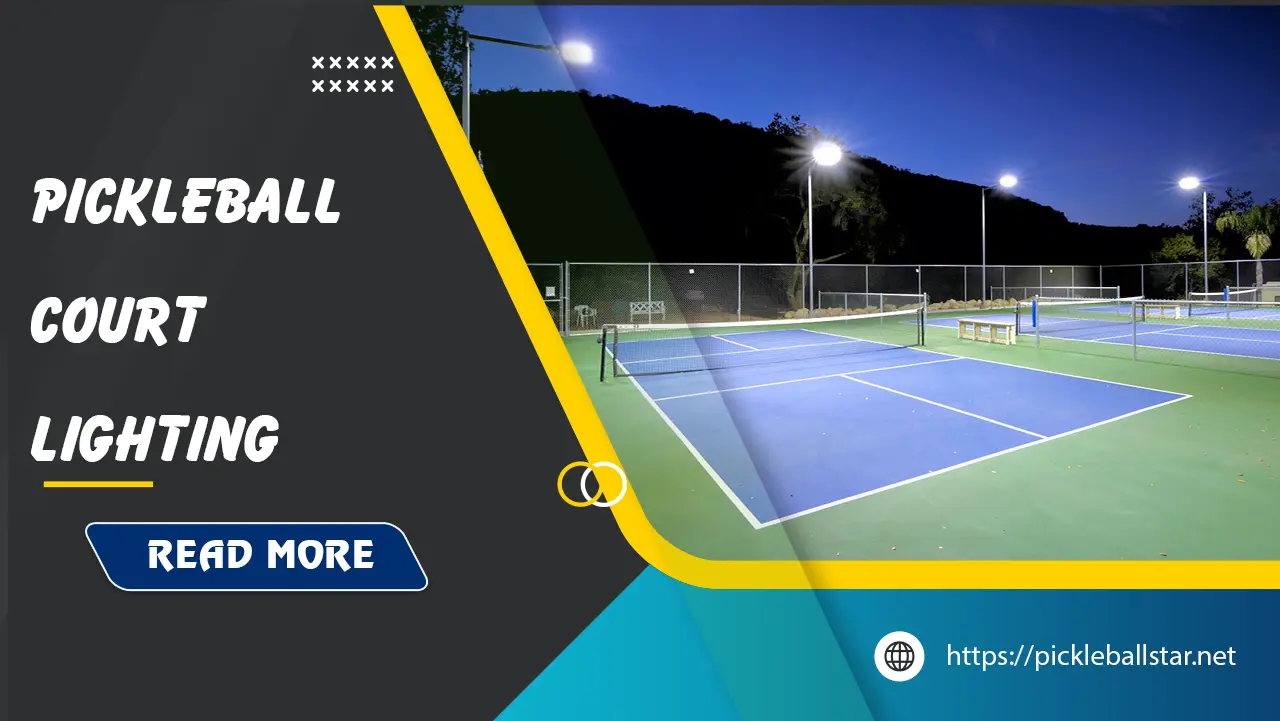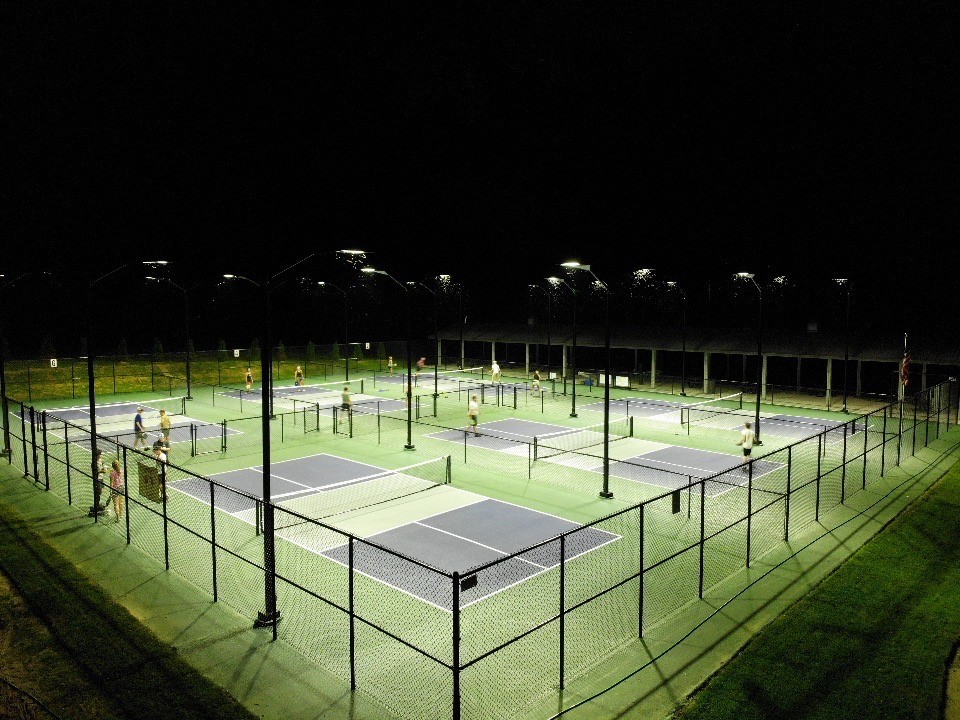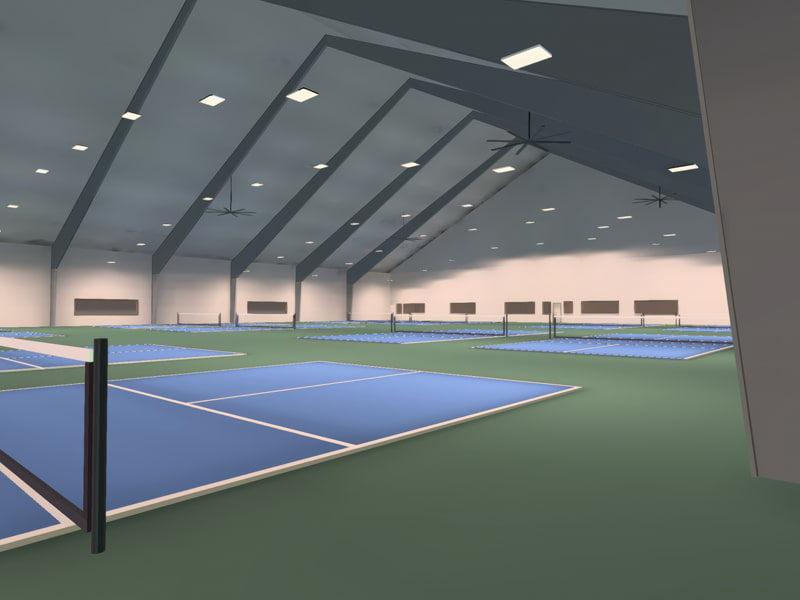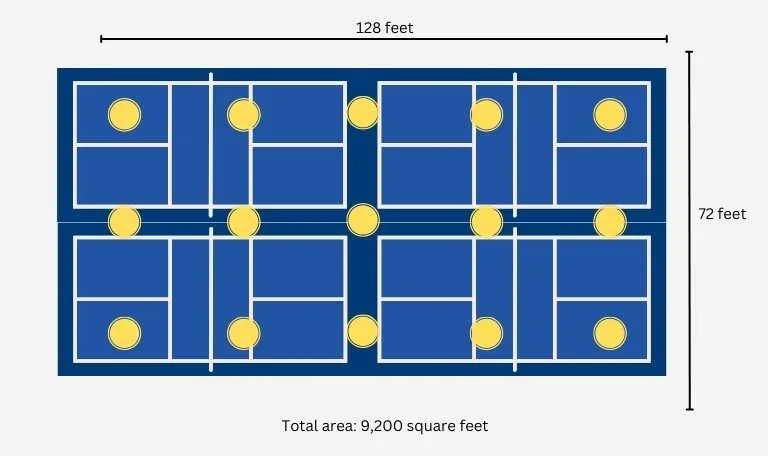Pickleball Court Lighting: Illuminating the Game
When the sun dips below the horizon, and the day turns into a tranquil evening, a new world of play emerges under the artificial glow of well-lit pickleball courts. For many, pickleball is not just a sport but a community activity, a source of joy, and a form of exercise. Thus, enabling players to continue their games after dusk is essential. Proper lighting transforms pickleball courts into beacons of fun, ensuring the game doesn’t have to end when daylight fades.

Proper lighting is crucial for multiple reasons. First and foremost, it enhances visibility, minimizes shadows, and ensures players can see and hit the ball accurately. Safety is another critical concern; adequate lighting prevents accidents and injuries by illuminating the entire court area. Furthermore, night games offer a different ambiance, providing a cooler, often less crowded environment for players compared to the sweltering daytime conditions. Understanding the nuances of pickleball court lighting ensures you maximize these benefits and continue the beloved game well into the night.
Lighting Requirements

Factors Affecting Light Levels
Several factors influence the required light levels for pickleball courts. These include the court’s size, the type of play (recreational vs. competitive), and even the surrounding environment. For example:
- Court Dimensions: Standard pickleball courts measure 20 feet by 44 feet, but the surrounding area must also be illuminated to ensure safety and comfort.
- Purpose of Play: Competitive play usually requires more stringent lighting standards than recreational play. The International Federation of Pickleball (IFP) suggests a minimum of 30 foot-candles for non-televised events.
- Environmental Factors: Urban areas with ambient light pollution might need different lighting adjustments than rural areas with minimal background illumination.
Measuring Light Levels
Measuring light levels ensures that the illumination on the court meets the desired standards. Here’s how you can measure light levels:
- Light Meters: Digital light meters can provide accurate readings of the light intensity in foot-candles or lux.
- Grid Method: Measure the light at different points on the court, ideally forming a grid pattern, to ensure uniform coverage.
- Record and Compare: Document the readings and compare them against recommended lighting guidelines to ensure adequacy.
Consequences of Inadequate Lighting
Inadequately lit pickleball courts can lead to several issues:
- Reduced Play Quality: Poor lighting can adversely affect players’ ability to see the ball, leading to missed shots and a less enjoyable game.
- Increased Risk of Injury: Shadows and poorly lit areas can cause trips, falls, and collisions.
- Strained Vision: Continuously playing under inadequate lighting can strain players’ eyes, leading to discomfort and potential long-term issues.
Understanding and implementing the right lighting requirements keeps the play enjoyable, safe, and competitive.
Types of Lighting
Overhead Lights

Overhead lights are a prevalent choice for pickleball courts. They offer consistent illumination across large areas, ensuring even the furthest corners are well-lit. Here are the advantages and disadvantages:
Advantages:
- Provide uniform light distribution
- Can be positioned to minimize shadows
- Suitable for both indoor and outdoor courts
Disadvantages:
- Installation might be complex and costly
- Potential for light pollution in residential areas
LED vs. Halogen Lights
When choosing the type of lights, LED and halogen are the foremost contenders.

LED Lights:
- Energy Efficiency: LEDs consume significantly less power, making them cost-effective in the long run.
- Lifespan: LEDs have a longer lifespan, often lasting over 50,000 hours, reducing maintenance costs.
- Brightness: LEDs provide bright, clear light that closely mimics natural daylight.
Halogen Lights:
- Initial Cost: Generally cheaper to purchase initially than LED lights.
- Brightness: Halogens can produce intensely bright light but often at a higher energy cost.
- Heat Production: Tend to generate more heat, which can be a drawback during warmer months.
Comparison Table:
| Feature | LED Lights | Halogen Lights |
|---|---|---|
| Energy Efficiency | High | Low |
| Lifespan | Up to 50,000 hours | Around 2,000 hours |
| Brightness | High | High |
| Cost | Higher initial cost | Lower initial cost |
Alternative Lighting Options
Innovative lighting solutions are also available beyond conventional LED and halogen lights.
Solar-Powered Lights:
- Eco-Friendly: Use renewable energy, making them environmentally friendly.
- Cost Savings: Reduced electricity bills as they utilize solar power.
- Limitations: Dependence on sunlight for charging, which can be less reliable in cloudy or winter seasons.
Motion-Activated Lights:
- Energy Efficiency: Only illuminate when needed, conserving energy.
- Enhanced Security: Offer added security by lighting up when someone approaches.
Each lighting type has its benefits and drawbacks, and the choice largely depends on specific requirements and constraints.
Installation and Placement

Optimal Placement of Fixtures
Proper placement of lighting fixtures is paramount to achieving uniform illumination. Here are some considerations:
- Height: Install lights at a height that provides even coverage without blinding the players. Generally, 20-30 feet high is optimal.
- Spacing: Space out the fixtures uniformly around the perimeter of the court to minimize shadows and dark spots.
- Angle: Position lights at angles that avoid glare directly into players’ eyes but effectively illuminate the playing surface.
Guidelines and Best Practices
Adhering to best practices can enhance the effectiveness of your lighting setup:
- Standards Compliance: Follow guidelines set by organizations like International Tennis Federation (ITF) or National Electric Code (NEC).
- Professional Installation: Hire certified professionals to ensure safety and efficiency.
- Regular Maintenance: Conduct routine checks and maintenance to keep the lights in optimal condition.
Cost Considerations
Several factors contribute to the overall cost of installing a pickleball court lighting system:
- Type of Lights: LED lights tend to be more expensive initially than halogen but have lower running costs.
- Number of Fixtures: More fixtures will obviously increase the cost.
- Installation Labor: Professional installation can be costly but ensures proper setup and safety compliance.
- Additional Features: Optional features like motion sensors or dimming capabilities can also add to the cost.
Example Cost Breakdown:
| Item | Estimated Cost |
|---|---|
| LED Light Fixtures | $1,000 per unit |
| Installation Labor | $500 – $1,000 |
| Additional Features (Sensors) | $200 per unit |
| Total Estimated Cost | $5,000 – $10,000 |
Understanding these aspects helps in budgeting and planning for a successful lighting project.
Safety and Aesthetics

Safety Hazards
Improper lighting installation can introduce several safety hazards, including:
- Electrical Hazards: Incorrect wiring or improper installation can lead to electrical shocks or fire hazards.
- Trip and Fall Risks: Poorly lit areas increase the risk of players tripping or falling.
- Glare and Shadows: Misplaced lights can cause glare, making it difficult for players to see and respond quickly, leading to potential injuries.
Ensuring Proper Light Levels
Maintaining the right light levels is crucial. Here are some tips:
- Dimmer Controls: Utilize dimmer switches to adjust the brightness according to the requirements.
- Regular Checks: Frequently check light levels to ensure they remain within the recommended range.
- Player Feedback: Encourage players to provide feedback on lighting conditions to make necessary adjustments.
Aesthetic Considerations
Aesthetics also play a vital role in court lighting. Here are some popular designs:
- Symmetrical Layout: Position lights symmetrically for a balanced and pleasing look.
- Color Temperature: Choose lights with a color temperature that mimics daylight for a natural playing environment.
- Concealed Fixtures: Use fixtures that blend in with the surrounding architecture for a seamless and professional appearance.
Incorporating these design elements can elevate the overall look and feel of the court while ensuring functionality.
Frequently Asked Questions
Regulations and Guidelines
There are specific regulations and guidelines for pickleball court lighting to ensure safety and fairness:
- IFP Guidelines: The International Federation of Pickleball suggests a minimum of 30 foot-candles for non-televised and 50 foot-candles for televised events.
- Local Codes: Always check local building codes and regulations to ensure compliance.
Finding Qualified Electricians
To find certified electricians for installing pickleball court lighting:
- Online Directories: Websites like HomeAdvisor or Angie’s List can help you find local professionals.
- Word of Mouth: Ask for recommendations from friends or fellow pickleball enthusiasts.
- Certification Checks: Ensure the electricians are certified and have experience with sports lighting installations.
Maintenance and Troubleshooting Tips
To maintain and troubleshoot your lighting system effectively:
- Routine Inspections: Schedule regular inspections to identify any issues early.
- Cleaning: Keep lights clean to ensure maximum brightness and efficiency.
- Replacement: Replace any faulty or dim lights promptly to maintain consistent illumination.
Quick Maintenance Tips:
- Clean fixtures every few months.
- Replace dying bulbs immediately.
- Check wiring annually.
Consistent Pickleball court maintenance ensures a safe and enjoyable playing experience.
Conclusion
Lighting plays a pivotal role in extending the joy of pickleball into the evening hours. Whether for recreational play or competitive matches, proper lighting ensures the game remains safe, enjoyable, and visually engaging. By understanding the lighting requirements, choosing the right types of lights, and following best practices for installation and maintenance, you can create a well-illuminated pickleball court that beckons players to continue their games under the stars.
Key Points to Remember:
- Adequate lighting enhances both safety and the quality of play.
- LED lights, while initially expensive, offer long-term savings and efficiency.
- Proper placement and regular maintenance of lights are crucial for optimal performance.
- Hiring certified professionals ensures the setup meets all guidelines and is safely installed.
Resources:
Creating a well-lit pickleball court is an investment in fun, safety, and the inclusive spirit of the game, lighting the way for memorable nighttime matches.
